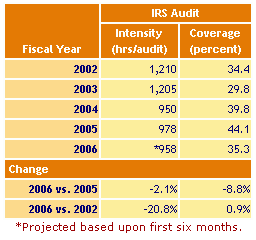Blog forwarding
I've started blogging at WordPress.
extremely moderate
 Newly released data from the IRS show that only 15% of large financial services companies — those with $250 million or more in assets — were audited in 2008, compared with 64% of all other similar sized corporations. And when they were performed, these financial service audits appear to have been less thorough than those in other industries.
Newly released data from the IRS show that only 15% of large financial services companies — those with $250 million or more in assets — were audited in 2008, compared with 64% of all other similar sized corporations. And when they were performed, these financial service audits appear to have been less thorough than those in other industries.  When a financial services firm was audited, the thoroughness of the audit — measured by the average hours the auditor spent — also was very different. For example, focusing only on the largest companies audited — those with $20 billion or more in assets — the audit for companies not in the financial sector averaged 3,145 hours of direct examiner time. Despite the unique challenge of understanding derivatives and the like, however, the audits for financial services giants averaged 1,695 hours, about half the time the typical audit took for all behemoths. This was not simply an anomaly; the identical pattern was found for all of the other categories of large corporations.
When a financial services firm was audited, the thoroughness of the audit — measured by the average hours the auditor spent — also was very different. For example, focusing only on the largest companies audited — those with $20 billion or more in assets — the audit for companies not in the financial sector averaged 3,145 hours of direct examiner time. Despite the unique challenge of understanding derivatives and the like, however, the audits for financial services giants averaged 1,695 hours, about half the time the typical audit took for all behemoths. This was not simply an anomaly; the identical pattern was found for all of the other categories of large corporations.  Because of the shrinking resources IRS was giving to the auditors in its Financial Services group, there has been a dramatic shift in which industry group is conducting audits of financial services firms. During FY 2004, the Financial Services group conducted most of the audits of the large financial services companies. But during the last five years the actual number of such audits declined by 27%. In contrast, over the same five year period, the audits completed of large financial companies by the four other nonfinancial industry groups more than doubled, up by 131%. The end result: the group that is currently charged with the responsibility for policing the financial services sector is today not conducting the majority of audits of large financial services corporations. This was true even for the largest of the large corporations, those with assets of $20 billion or more.
Because of the shrinking resources IRS was giving to the auditors in its Financial Services group, there has been a dramatic shift in which industry group is conducting audits of financial services firms. During FY 2004, the Financial Services group conducted most of the audits of the large financial services companies. But during the last five years the actual number of such audits declined by 27%. In contrast, over the same five year period, the audits completed of large financial companies by the four other nonfinancial industry groups more than doubled, up by 131%. The end result: the group that is currently charged with the responsibility for policing the financial services sector is today not conducting the majority of audits of large financial services corporations. This was true even for the largest of the large corporations, those with assets of $20 billion or more.Labels: audits, financial services, IRS, taxes, TRAC
 The new TRAC report on DHS Immigration Enforcement has gotten extensive coverage by the traditional news media, including CNN, the Washington Post, the Associated Press, Time, US News and World Report and the Orange County Register. It's also been picked up in the blogosphere, by Bruce Shneier and others.
The new TRAC report on DHS Immigration Enforcement has gotten extensive coverage by the traditional news media, including CNN, the Washington Post, the Associated Press, Time, US News and World Report and the Orange County Register. It's also been picked up in the blogosphere, by Bruce Shneier and others. Labels: DHS, immigration, terrorism
 Last week I was skimming through the Central New York folk music concert calendar compiled by local folkie Larry Hoyt. I was surprised — and thrilled — to find playing nearby a new incarnation of an old favorite act: John and Mary and the Valkyries.
Last week I was skimming through the Central New York folk music concert calendar compiled by local folkie Larry Hoyt. I was surprised — and thrilled — to find playing nearby a new incarnation of an old favorite act: John and Mary and the Valkyries.  The Mary would be, yes, Mary Ramsey, who did some session and touring work on the last two 10,000 Maniacs albums before Natalie Merchant went solo. Both John and Mary rejoined the band after Natalie left, staying for two more albums.
The Mary would be, yes, Mary Ramsey, who did some session and touring work on the last two 10,000 Maniacs albums before Natalie Merchant went solo. Both John and Mary rejoined the band after Natalie left, staying for two more albums.  I was quite pleased to see 10,000 Maniacs' Jerome Augustinyak on drums; Jerry is probably the best drummer I've ever seen, and I've seen some pretty good drummers, including Jerry Marotta, Eddie Hartness (of Eddie from Ohio) and Dave Hower (from the Nields). John saw me waiting outside and gave me a nod of recognition, which made me feel like it had already been worth the hassle of getting there: many musicians have told me they enjoy recognizing a friendly face when they're on the road.
I was quite pleased to see 10,000 Maniacs' Jerome Augustinyak on drums; Jerry is probably the best drummer I've ever seen, and I've seen some pretty good drummers, including Jerry Marotta, Eddie Hartness (of Eddie from Ohio) and Dave Hower (from the Nields). John saw me waiting outside and gave me a nod of recognition, which made me feel like it had already been worth the hassle of getting there: many musicians have told me they enjoy recognizing a friendly face when they're on the road. After the soundcheck, John sat and chatted with me for a few minutes before the show started. I never know what to say in these circumstances, I think I muttered something about my oldest kid, the one who at 18 months old danced in a diaper in front of them at the Great Blue Heron Festival, was now 14 and as tall as me. I showed him some family pictures that were still on my camera and listened to him talk about where his life is and the state of live music in Buffalo. I've always enjoyed getting a minute or two with John; he's very friendly and serious and low-key and knows a huge amount about art and music. Listening to him is like auditing a college lecture by a very cool professor. I was disappointed when he said they wouldn't do a lot of their old stuff, but he showed me the set list and there was enough good old stuff there to get me in a very positive frame of mind. As was typical for a John and Mary set, there were a mix of old Maniacs tunes that John co-wrote, John and Mary songs, and a few interesting covers, although missing were the traditional but obscure folk tunes that used to be a John and Mary staple. Also missing were any songs from the forthcoming John and Mary CD; according to John it's 90% done and they're hoping to have it ready for July 4 and the Great Blue Heron festival.
After the soundcheck, John sat and chatted with me for a few minutes before the show started. I never know what to say in these circumstances, I think I muttered something about my oldest kid, the one who at 18 months old danced in a diaper in front of them at the Great Blue Heron Festival, was now 14 and as tall as me. I showed him some family pictures that were still on my camera and listened to him talk about where his life is and the state of live music in Buffalo. I've always enjoyed getting a minute or two with John; he's very friendly and serious and low-key and knows a huge amount about art and music. Listening to him is like auditing a college lecture by a very cool professor. I was disappointed when he said they wouldn't do a lot of their old stuff, but he showed me the set list and there was enough good old stuff there to get me in a very positive frame of mind. As was typical for a John and Mary set, there were a mix of old Maniacs tunes that John co-wrote, John and Mary songs, and a few interesting covers, although missing were the traditional but obscure folk tunes that used to be a John and Mary staple. Also missing were any songs from the forthcoming John and Mary CD; according to John it's 90% done and they're hoping to have it ready for July 4 and the Great Blue Heron festival. The show itself was wonderful. The band was tight, which isn't surprising since in addition to Jerry (who was filling in for drummer Rob Lynch) the band included John's old friends Patrick Kane (lead guitar) and Kent Weber (bass). I can never get enough of Mary's 5-string Zeta; I enjoyed what I got but there was less of her blistering solo work than in some past concerts. And of course, she didn't pick up a guitar (which she plays, though rarely) or accordion (yes, I've seen her play one). I took some crappy video with my Canon PowerShot which I'll share provided you don't take me to task on the lack of visual or aural fidelity.
The show itself was wonderful. The band was tight, which isn't surprising since in addition to Jerry (who was filling in for drummer Rob Lynch) the band included John's old friends Patrick Kane (lead guitar) and Kent Weber (bass). I can never get enough of Mary's 5-string Zeta; I enjoyed what I got but there was less of her blistering solo work than in some past concerts. And of course, she didn't pick up a guitar (which she plays, though rarely) or accordion (yes, I've seen her play one). I took some crappy video with my Canon PowerShot which I'll share provided you don't take me to task on the lack of visual or aural fidelity. When called on the facts that they're conducting fewer audits of large companies (assets over $250 million), and spending less time when they do, the IRS disagrees that it's giving the big boys a break.
When called on the facts that they're conducting fewer audits of large companies (assets over $250 million), and spending less time when they do, the IRS disagrees that it's giving the big boys a break.IRS spokesman Terry Lemons said the agency strongly disagreed with TRAC's conclusion that the biggest corporations were getting off easy. "Large corporations are not getting easier treatment," he said. "They are hearing more often from us and getting bigger tax bills."
He said that, between 2002 and 2006, the recommended levy per return for audits of corporations with assets of $250 million and up had gone from $3.65 million to just under $6 million.
Prof. Sue Long, a director of the Syracuse clearinghouse, said getting the data used in the research had been a problem. The I.R.S., Professor Long said, initially turned over a small number of pages of data in May after Judge Marsha Pechman of Federal District Court in Washington directed the I.R.S. to resume complying with a 1976 order to make the data available. Later, after she complained, the I.R.S. turned over much more data.
Professor Long said the data was a mess. "It took us months to sort it out," she said.
"They told us they had given us all of it, but we noticed from the page numbers in the upper right hand corner that they had not and it turned out they had given us less than 1 percent of the data" that the university researchers eventually received, Professor Long said.
In addition, she said, it is difficult to tell if the data is complete because the I.R.S. will not provide an inventory.
The Supreme Court rejected the government's interpretation of immigration law on Tuesday, ruling that a noncitizen is not subject to mandatory deportation for a drug crime that, while a felony in the state where the crime was prosecuted, is only a misdemeanor under federal law.Here's a reference for aggravated felony. But in a nutshell, under U.S. Immigration law, a legal immigrant can be deported for immigration violations, national security and terrorism activities, or criminal violations. With the Anti-Drug Abuse Act of 1988, Congress got specific about the kinds of crimes that would justify deportation by creating the concept of aggravated felony, which specifies as grounds for deportation murder, drug trafficking, and illegal trafficking in firearms and destructive devices.
The 8-to-1 decision restored to one category of immigrants, caught in the nearly impenetrable maze where immigration law and criminal law meet, the ability to avoid automatic deportation and the other dire consequences of being guilty of an "aggravated felony."
The law does not apply to illegal immigrants, and it has not been used primarily against recent immigrants either. In fact, the median length of residence for individuals charged under this law has been 14 years. That means half the people charged have been legally living and working in the
- Ineligible to stop deportation. Many other deportable offenses allow a non-citizen to be able to apply for "waivers", or exceptions, to deportation. But no exceptions are available to aggravated felons.
- Unable to apply for other legal immigration status. Many persons with other violations, including some criminal violations that make them deportable, remain eligible to apply for asylum, lawful permanent residence (green card), and other routes to legal status spelled out in the INA if they meet other qualifications. Aggravated felons are disqualified from almost every provision of the law that would enable them to legalize their status or to retain existing legal status, such as a green card.
- Guaranteed to be detained. Aggravated felons, in addition to several other types of non-citizens, fall within the INA's "mandatory detention" provisions. This means that most will be detained until DHS is able to effect their deportation.
- Less access to immigration court. For the most part, non-citizens can only be deported after an Immigration Judge conducts a hearing and signs an "order of removal (deportation)". However, the INA allows DHS to deport aggravated felons who are not green card holders "administratively", that is, within the agency without having to take the case before an Immigration Judge.
- Less access to federal appeals courts. Aggravated felons are among a group of deportable non-citizens who have fewer legal rights to request a federal judge hear their case on appeal.
- Permanent ejection from the US. Most non-citizens who are deported from the US are not eligible to apply to return legally to the country for a period of from five to 20 years depending on their circumstances. But aggravated felons are permanently disqualified from ever returning to the US for any reason.